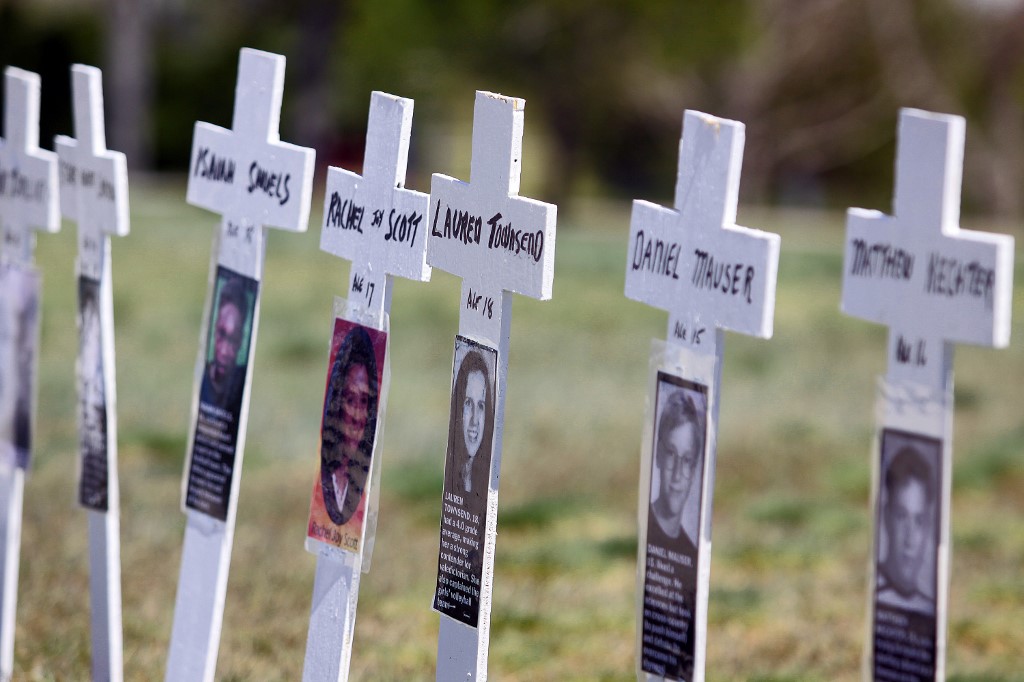
In this April 20, 2009 file photo, miniature crosses are displayed to commemorate the ten-year anniversary of the Columbine High School shootings at Clement Park in Littleton, Colorado. Columbine was the site of the then deadliest school shooting in modern United States history when, on April 20, 1999, 2 students killed 12 of their schoolmates and one teacher, and wounded 23 others, before taking their own lives. Marc Piscotty/Getty Images/AFP
WASHINGTON — As the superintendent of Jefferson County School District in Colorado, Jason Glass oversees one of the most troubled pieces of property in the United States: Columbine High School.
The site of the one of the first — and still among the deadliest — school shootings in the country, Columbine has proved an enduring headache for the school district ever since two students killed 12 of their classmates, a teacher and themselves in 1999.
In an open letter published this week, Glass detailed how every year hundreds of people try to get on campus to “reconnect with the 1999 murders,” while in the years that followed, many other school shooters took inspiration from the Columbine attack.
Around the 20th anniversary of the killings this year, reports that an armed woman had traveled to the area triggered a lockdown of the high school — and of many other schools in the area — only for the woman to be found dead, an apparent suicide.
“Columbine High School has a gravitational pull for these sorts of individuals,” Glass wrote. “Most of them are there to satisfy curiosity or a macabre, but harmless, interest in the school. For a small group of others, there is a potential intent to do harm.”
Now the school district is considering following the dramatic example set by many other property owners whose buildings were the site of carnage.
“Today school safety experts recommend tearing down buildings where school shootings take place,” Glass said. “Since the morbid fascination with Columbine has been increasing over the years, rather than dissipating, we believe it is time for our community to consider this option for the existing Columbine building.”
Such a move is not undertaken lightly. Glass said officials were considering asking voters to approve a rise in property taxes to provide “an additional $60-$70 million” to build a new high school with added safety features.
Yet despite efforts to improve security in US schools and other public buildings in the 20 years since the Columbine killings, the United States still sees hundreds of mass shootings every year.
In a bid to halt the bloodshed, authorities now strive to deny the killers the infamy many of them seek.
Late last month, after a city employee killed 12 people in a Virginia municipal building, police and elected officials paid tribute to the victims but made a point of rarely speaking the killer’s name.
“I did it once,” Virginia Beach police chief James Cervera said in an interview.
After announcing the shooter’s name at a press conference, he took to referring to the man as “the suspect,” or “the shooter.”
‘Contagion’
Researchers say the “copy-cat effect,” in which mass shooters take inspiration from other mass shooters in pursuit of fame and recognition, is real.
Sherry Towers, a professor of mathematics at Arizona State University, applied models usually used for studying diseases to mass shootings.
She told AFP high-profile mass shootings that attracted lots of media attention prompted a “contagion,” inspiring others.
Adam Lankford, a professor of criminology at the University of Alabama, said some mass shooters get as much media attention as Hollywood movie stars.
“That’s a reward that imitators are pursuing,” he said. “Some mass shooters explicitly said that infamy is better than obscurity.”
Towers said there was a growing understanding among news outlets and politicians that the public eye should not be focused on the perpetrators.
Following the killings of 51 people at two mosques in Christchurch in March, New Zealand’s Prime Minister Jacinda Ardern vowed never to mention the shooter’s name.
“He is a terrorist. He is a criminal. He is an extremist. But he will, when I speak, be nameless,” she said.
But with “more and more people… gathering their news on social media,” keeping the name of the killer out of the public eye is “much more difficult to control.”
Even if his name is forgotten, the Australian behind the Christchurch attack broadcast his murders live on Facebook.
A few weeks later, an American man opened fire in a California synagogue, killing a woman and injuring three other people.
In a letter posted shortly before the assault, the shooter quoted the Australian by name, calling him an inspiration.